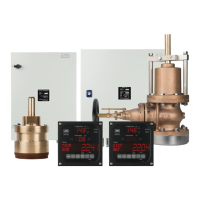6-49
Examples of proper tools for crimping end caps, and a strip of end caps
Shields
Grounding a screen “for safety” or “for good measure” could ruin noise immunity. Forming a
ground loop will let noise slip into the system.
Note: Shields shall never be connected in both ends of a signal cable, unless expressly noted.
The reason for this is that the chassis (bulkhead) potential is never the same in both ends of the
cable. Although the ship is made of steel, large currents flowing through the hull may easily
generate a potential difference of several volts between different sections of the ship. The result
is that noise current will start flowing from the “high” end of the screen to the “low” end,
maybe several amperes. On the way, it will induce into the signal leads, causing signal
degradation and improper operation of the Speed-log system.
The screen shall not be routed into the cabinet. It shall be connected to ground in the cable inlet,
either in the cable gland or in the ground rail directly when entering the cabinet. If the shield is
not to be connected it shall be cut of and isolated directly when entering the cabinet.
Where there is a risk that the shield wire can make short circuit to anything, solder traces, other
wires, chassis, bulkhead, etc., it must be protected with a slip-on plastic tube or shrink tubing.
Remember that the screen is not meant to carry any current or signal, it is only a screen.
Cable installation
Never strap high-current, noisy cables together with sensitive signal cables, shielded or
unshielded. The reason is once again to avoid noise induction. Two cables lying tightly together
work like a transformer and the noise in one cable is easily coupling to the other. The cheapest
measure of noise reduction is to keep sensitive cables away from noisy cables. Doing this at the
installation stage is much cheaper than fault-finding and re-engineering it later.
Note: All cables must be properly ID-marked (numbered) in both ends!

